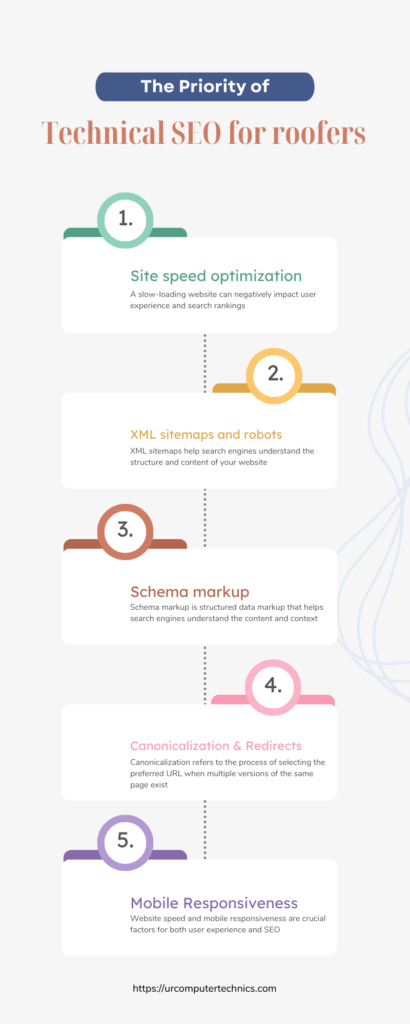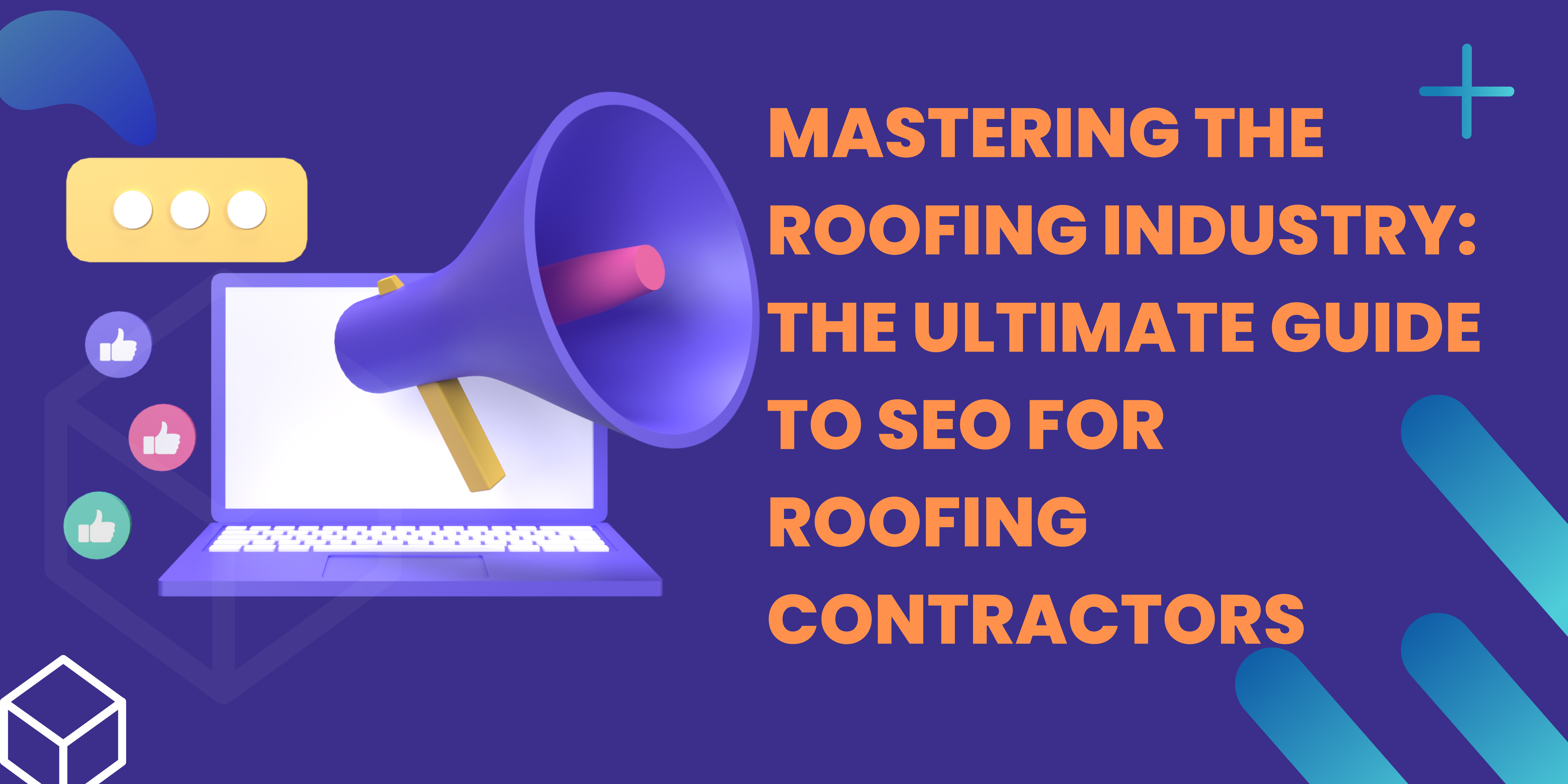With an increasing number of consumers turning to the internet to find local services, search engine optimization (SEO) has become an essential strategy for roofers looking to boost their visibility and attract new customers. By implementing effective SEO SEO for Roofing, businesses can improve their online rankings, increase website traffic, and generate valuable leads for roofing industry. Learn how to do car rental SEO, SEO for plumbers, SEO for construction, SEO for pest control and SEO for Window Cleaning Companies.
Understanding SEO for Roofers
A. What is SEO?
Search engine optimization (SEO) is the process of improving a website’s visibility and organic search rankings on search engine results pages (SERPs). It involves optimizing various aspects of a website, including its content, structure, and external factors, to make it more attractive to search engines. The goal of SEO is to increase the visibility of a website in relevant search results, driving organic traffic and generating valuable leads.
B. How search engines work
To understand SEO, it’s essential to have a basic understanding of how search engines work. Search engines use complex algorithms to analyze and index websites, determining their relevance and ranking in search results. These algorithms consider factors such as keyword relevance, website authority, user experience, and backlink profile. By optimizing a website according to these factors, roofers can improve their chances of ranking higher in search engine results.
C. SEO vs. PPC: Benefits and differences
While SEO focuses on organic search results, pay-per-click (PPC) advertising involves paid advertisements displayed alongside search results. Both SEO and PPC have their benefits and differences. SEO provides long-term visibility and sustainability, as it is based on organic rankings. It requires continuous effort and optimization but can deliver valuable and cost-effective results. On the other hand, PPC allows for immediate visibility and control over ad placement but requires ongoing investment to maintain visibility.
D. The role of SEO in the roofing industry
The roofing industry is highly competitive, with numerous local and national players vying for customers. In such a landscape, SEO plays a crucial role in helping roofing businesses stand out and attract potential customers. A well-executed SEO strategy can enhance a roofer’s online visibility, increase brand awareness, drive targeted traffic, and ultimately generate more leads and conversions. By understanding and implementing effective SEO techniques, roofing businesses can gain a competitive edge and establish themselves as trusted industry authorities.
Key Elements of SEO for Roofing Industries
A. Keyword research
Identifying relevant keywords SEO for roofing services

Keyword research is a fundamental aspect of SEO. It involves identifying the keywords and phrases that potential customers are likely to use when searching for roofing services. For roofers, this could include keywords related to roof repair, installation, maintenance, or specific roofing materials. It is essential to understand the search intent behind these keywords and target those that align with the services provided by your roofing business.
Long-tail keywords and their importance
Long-tail keywords are more specific and detailed keyword phrases that are longer in length. While they may have lower search volumes compared to broader keywords, they often have higher conversion rates. Roofers can leverage long-tail keywords to target potential customers who are closer to the decision-making stage. For example, instead of targeting a broad keyword like “roof repair,” a long-tail keyword like “emergency roof repair in [city name]” can attract more qualified leads.
Tools for keyword research
There are several keyword research tools available that can help roofers identify relevant keywords and assess their search volumes and competition. Tools like Google Keyword Planner, SEMrush, Moz Keyword Explorer, and Ahrefs Keyword Explorer can provide valuable insights into keyword opportunities and help refine your SEO strategy.

On-page optimization for Roofers
- Title tags, meta descriptions, and headers: On-page optimization involves optimizing various on-page elements to make your website more search engine-friendly. This includes optimizing title tags, meta descriptions, and headers with relevant keywords. These elements provide search engines and users with information about the content on your webpage, influencing click-through rates and search rankings.
- Optimizing website content with keywords: Create high-quality and informative content that incorporates relevant keywords naturally. Avoid keyword stuffing and focus on creating content that provides value to users. Optimize headings, subheadings, and body text with relevant keywords to improve the visibility and relevance of your content.
- URL structure and internal linking: Ensure that your website has a clear and user-friendly URL structure that reflects the hierarchy of your content. Use descriptive keywords in your URLs to improve search engine visibility. Additionally, implement internal linking strategies to guide search engines and users to relevant pages within your website. Internal links help distribute link authority and improve the overall user experience.

Technical SEO for roofers
- Site speed and mobile optimization: Site speed and mobile optimization are critical factors in SEO. A slow-loading website can negatively impact user experience and search rankings. Optimize your website’s performance by minimizing file sizes, leveraging browser caching, and using a content delivery network (CDN) if necessary. Mobile optimization involves ensuring that your website is responsive and displays correctly on various mobile devices.
- XML sitemaps and robots.txt: XML sitemaps help search engines understand the structure and content of your website, making it easier for them to crawl and index your pages. Create an XML sitemap and submit it to search engines to ensure all your web pages are discovered and indexed. The robots.txt file helps control the crawling and indexing of specific pages on your website. Use it to specify which pages search engines should or should not crawl.
- Schema markup for local SEO: Schema markup is structured data markup that helps search engines understand the content and context of your website. For local SEO, you can use schema markup to provide search engines with information about your roofing business, such as your address, phone number, business hours, and customer reviews. Implementing schema markup can enhance your visibility in local search results and improve your chances of appearing in rich snippets.
Off-page optimization for Roofers
- Importance of backlinks for SEO: Backlinks, or links from other websites pointing to your site, are crucial for SEO success. Search engines consider backlinks as votes of confidence and authority. Aim to acquire high-quality backlinks from reputable roofing and industry-related websites. These backlinks can help improve your website’s authority, visibility, and search rankings.
- Building high-quality backlinks for roofers: Building high-quality backlinks requires a proactive approach. Reach out to authoritative roofing blogs, industry publications, and related websites to explore opportunities for guest blogging, collaboration, or partnerships. By creating valuable content and fostering relationships with other website owners, you can naturally attract backlinks to your site.
- Guest blogging and influencer outreach: Guest blogging involves writing and publishing articles on other websites as a guest author. This allows you to showcase your expertise, build brand awareness, and acquire backlinks. Influencer outreach involves collaborating with influential individuals or companies in the roofing industry to gain exposure and attract a wider audience. Both strategies can contribute to off-page optimization and help improve your SEO efforts.

Local Services SEO for roofers
- Optimizing Google My Business profile: Google My Business (GMB) is a powerful tool for local SEO. Claim and optimize your GMB profile by providing accurate business information, such as your address, phone number, business hours, and website URL. Encourage customers to leave reviews on your GMB listing, as positive reviews can boost your local search visibility.
- Local directory listings and citations: Ensure consistent and accurate NAP (name, address, phone number) information across various local directory listings, such as Yelp, Yellow Pages, and local chamber of commerce websites. These listings and citations help establish the credibility and legitimacy of your roofing business, enhancing your local SEO efforts.
- Online reviews and reputation management: Online reviews play a significant role in local SEO and consumer decision-making. Encourage satisfied customers to leave positive reviews on platforms like Google, Yelp, and Angie’s List. Respond to both positive and negative reviews in a professional and timely manner to demonstrate your commitment to customer satisfaction. Monitor and manage your online reputation to maintain a positive brand image.
Content Marketing for Roofers
A. Creating valuable and engaging content
Content marketing is a powerful strategy for attracting and engaging potential customers. Create informative and valuable content that addresses common roofing concerns, provides DIY tips, or educates customers about the importance of professional roofing services. By offering helpful content, you can establish your roofing business as an authority and build trust with your audience.
B. Blogging for roofing businesses
Maintain an active blog on your website to regularly publish relevant and informative articles. Focus on topics that address customer pain points, answer frequently asked questions, or provide updates on industry trends. Optimize blog posts with relevant keywords and promote them through social media and email marketing to expand your reach and attract organic traffic.
C. Video marketing for roofers
Video marketing is a highly engaging and effective content format. Create videos that showcase your roofing services, provide educational tutorials, or share customer testimonials. Host these videos on your website and promote them through video-sharing platforms like YouTube. Optimize video titles, descriptions, and tags with relevant keywords to improve visibility in search results.
D. Social media strategies for roofers
Utilize social media platforms to connect with your audience, share valuable content, and promote your roofing services. Identify the platforms where your target audience is most active and create a consistent posting schedule. Engage with your followers, respond to comments and messages, and use social media advertising to expand your reach and attract potential customers.
Measuring SEO Success for Roofing Businesses
A. Setting SEO goals and KPIs
To measure the success of your SEO efforts, it’s important to set specific goals and key performance indicators (KPIs). Common SEO goals include improving search rankings, increasing organic website traffic, generating leads, and boosting conversions. Align your goals with your business objectives and track relevant KPIs to assess the effectiveness of your SEO strategy.
B. Tools for tracking and analytics
Several tools can help you track and analyze your website’s performance and SEO metrics. Google Analytics provides valuable insights into website traffic, user behavior, and conversions. Google Search Console allows you to monitor your website’s visibility in search results, identify crawl errors, and track keyword rankings. Other SEO tools like SEMrush, Moz, and Ahrefs offer comprehensive analytics and reporting features.
C. Monitoring website traffic and rankings
Regularly monitor your website’s traffic metrics, such as the number of organic visits, page views, and time spent on site. Analyze trends and identify areas of improvement. Additionally, track your website’s search rankings for relevant keywords to assess your visibility in search results and make informed optimizations.
D. Conversion tracking and ROI analysis
Track and analyze conversions to understand how effectively your SEO efforts are driving valuable actions on your website, such as form submissions, quote requests, or phone calls. Assign values to conversions to calculate the return on investment (ROI) of your SEO campaigns. This analysis can help you optimize your SEO strategy and allocate resources effectively.
Challenges and Solutions for SEO in the Roofing Industry
A. High competition and local SEO strategies
The roofing industry is highly competitive, with numerous businesses vying for customers in local markets. To overcome this challenge, focus on local SEO strategies that target specific geographic areas. Optimize your website for location-based keywords, create localized content, and build relationships with local businesses and influencers to enhance your local search visibility.
B. Seasonality and adapting SEO campaigns
The roofing industry is often affected by seasonality, with peak demand during certain times of the year. Adapt your SEO campaigns to align with seasonal trends and optimize your website and content accordingly. For example, during the winter months, emphasize services like roof inspections and repairs for winter weather preparation.
C. Staying updated with algorithm changes
Search engine algorithms constantly evolve, and staying updated with these changes is crucial for maintaining SEO success. Regularly monitor industry news, follow reputable SEO blogs and forums, and stay informed about algorithm updates from search engines like Google. Adapt your SEO strategies accordingly to ensure your website remains optimized and compliant with the latest algorithms.
D. Hiring an SEO professional or agency
If managing SEO in-house becomes overwhelming or if you lack the expertise, consider hiring an SEO professional or agency specializing in the roofing industry. An experienced SEO provider can help develop and execute a customized SEO strategy, stay on top of industry trends, and deliver measurable results. Be sure to vet potential providers, review their portfolio and client testimonials, and ensure they have a proven track record in the roofing industry.
Future Trends in SEO for Roofers
A. Voice search and its impact on local SEO
Voice search is rapidly gaining popularity, with more users relying on voice-activated devices and virtual assistants to perform searches. Roofers need to optimize their websites for voice search by targeting long-tail conversational keywords and providing direct, concise answers to common questions. Emphasizing local SEO is also crucial, as voice searches often have a local intent.
B. Mobile-first indexing and mobile optimization
As mobile usage continues to rise, search engines prioritize mobile-first indexing, meaning they consider the mobile version of a website as the primary source for indexing and ranking. Roofers must ensure their websites are mobile-friendly, responsive, and provide an excellent user experience on mobile devices. Mobile optimization includes optimizing page load speed, ensuring readability, and implementing touch-friendly elements.
C. Artificial intelligence and machine learning in SEO
Artificial intelligence (AI) and machine learning algorithms are becoming increasingly sophisticated, impacting how search engines understand and rank websites. Roofers can leverage AI-powered tools to analyze data, identify trends, and make data-driven decisions for their SEO strategies. AI can assist in keyword research, content optimization, and predictive analysis, providing valuable insights and automation opportunities.
Conclusion
A. Recap of key points discussed in the article
In the conclusion, we will summarize the key points covered throughout the article, highlighting the importance of SEO for roofing businesses and the various strategies and techniques discussed.
B. Encouraging roofers to invest in SEO for online success
We will emphasize the long-term benefits of investing in SEO for roofing businesses. By optimizing their online presence, roofers can attract more qualified leads, increase brand visibility, and outperform competitors in search engine rankings.
C. The long-term benefits of SEO for roofing businesses
Lastly, we will reiterate the long-term benefits of SEO, such as sustained organic traffic, increased conversions, improved online reputation, and higher return on investment. Encouraging roofers to make SEO a priority and continually adapt their strategies to stay ahead in the ever-changing digital landscape.

I would like to introduce myself as Uttam, an Internet Marketing Expert and professional a blogger and founder of Ur Computer Technics. Also, I’m a passionate entrepreneur, SEO Specialist, and fitness freak.







